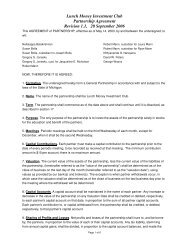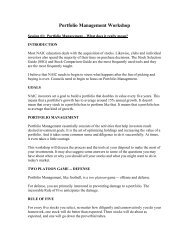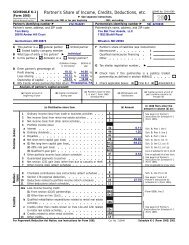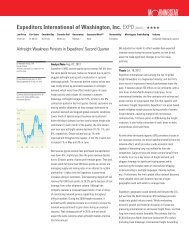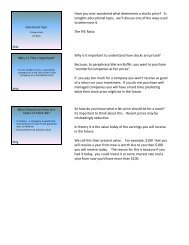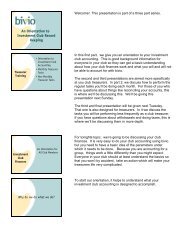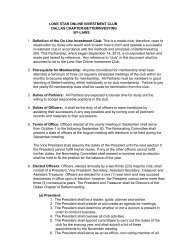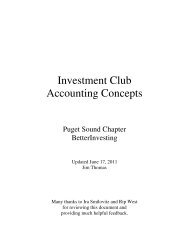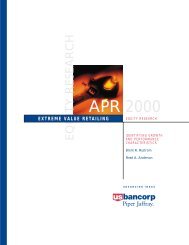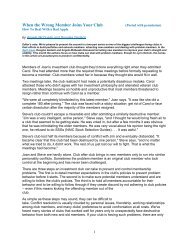Introduction Optional Reading Workshop Content - Bivio
Introduction Optional Reading Workshop Content - Bivio
Introduction Optional Reading Workshop Content - Bivio
You also want an ePaper? Increase the reach of your titles
YUMPU automatically turns print PDFs into web optimized ePapers that Google loves.
RAW - Liquidity2 applies to manufacturing companies; but there is no guidance aboutwhat values should be used for other types of companies. Can anyoneelse provide some insight about appropriate values for the CurrentRatio? For now, my suggestion is to compare the current ratio of acompany with the average for its industry.THE BALANCE SHEETCurrent Assets and Current Liabilities are listed in a company'sBalance Sheet. Current Assets are the first sub-total at the top of thelist of assets. Current Liabilities are the first sub-total at the topof the list of liabilities. Knowledge of the components that are summedto calculate current assets and current liabilities will be helpful forinterpreting the significance of the current ratio.Current Assets are those assets that will normally convert to cashwithin one year or the company's normal business cycle, whichever islonger.Current Assets usually consist of four components:Cash and EquivalentsAccounts ReceivableInventoryOtherNote that the four components are listed in order of the relative timeit usually takes to convert them to cash. Cash and Equivalents arealready in the form of cash. Accounts Receivable represent inventorythat has been sold on credit and delivered to customers; it may take 30to 90 days until the customers pay with cash. Inventory still has to besold; then it will take another 30 to 90 days before payment will bereceived. Other is a catchall category for all other assets that willbe converted to cash sometime within a year.Next consider Current Liabilities. These are liabilities that willnormally be settled with cash within one year. The components ofcurrent liabilities are not as standardized as the components ofcurrent assets. However, typical components of current liabilitiescould include:Accounts payableNotes payable to banksCurrent maturity of long term debtCurrent potion of capital lease paymentsAccrued taxesOtherTHE VALUE LINE CURRENT POSITION BOXValue Line shows current assets and current liabilities in a boxlabeled CURRENT POSITION. This box is located a little over half waydown on the left side of a value Line sheet. The box shows three setsof current position data; data for each of the past two years plus thecurrent position at the end of the most recently reported quarter. Notethat value Line uses the same components for current assets that werelisted above. However, Value Line separates current liabilities intojust three components:Accounts payableDebt dueOtherAccounts payable listed by Value Line is the same as the Accountspayable listed above.Debt due listed by Value Line includes items such as Notes payable toPage 2



